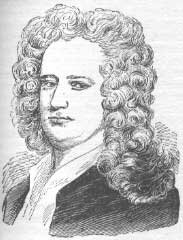









|
Joseph Addison
(1672-1719)
 Joseph Addison was the son of a dean of Lichfield. He was educated at the
Charterhouse, then Oxford and Magdalen. He was a distinguished classical
scholar and attracted the attention of Dryden by his Latin poems. From 1699
to 1703, he traveled in the continent. The Dialogues Upon the Usefulness
of Ancient Medals was probably written about this time. The Campaign
in heroic couplets in celebration of the victory of Blenheim appeared in
1705. He was appointed undersecretary of state the next year and MP from
1708 till his death. In 1709, he went to Ireland as chief secretary to Lord
Wharton. Then he became one of the outstanding figures in the Kit-Kat Club
and formed a close relationship with Steele, Swift and other writers. In
1711, Addison failed his post as the fall of the Whigs.
Joseph Addison was the son of a dean of Lichfield. He was educated at the
Charterhouse, then Oxford and Magdalen. He was a distinguished classical
scholar and attracted the attention of Dryden by his Latin poems. From 1699
to 1703, he traveled in the continent. The Dialogues Upon the Usefulness
of Ancient Medals was probably written about this time. The Campaign
in heroic couplets in celebration of the victory of Blenheim appeared in
1705. He was appointed undersecretary of state the next year and MP from
1708 till his death. In 1709, he went to Ireland as chief secretary to Lord
Wharton. Then he became one of the outstanding figures in the Kit-Kat Club
and formed a close relationship with Steele, Swift and other writers. In
1711, Addison failed his post as the fall of the Whigs.
During 1709 to 1711, he composed a number of papers to
the Tatler, and then in 1711 after the end of Tatler, he
joined with Steele, they produced the Spectator, which was a daily
paper published one essay each day. The Spectator was assumed to be
edited by a small club headed by Mr. Spectator. Mr. Spectator was supposed
to be a man of travel and learned and frequent London as an observer, was
the image of a new culture and the ideal spokesman of the middle class of
the 18th century. Through the mouth of Mr. Spectator and other fancied
figures, Addison and Steele mildly preached the essence of Enlightenment:
reason, self-control, civility, refinement and good taste. By humour, wit,
knowledge of the world and truth, they attempted to fit the pressing need of
the newly rising ruling class-- the bourgeoisie on shaping a new social
order. In the describing of the figures, some character sketches came up
which became the forebear of the English novel.
In 1713, Cato, his neo-classical tragedy came out and
harvested a great success; however, his The Drummer(1715)showed a
failure. In 1716, he became a lord commissioner of trade and in 1718 he
retired from office with a pension of 1500 pounds. The increasing tension in
his friendship with Steele marked his last year.
Compared to Steele’s style, which is intimate, easy-going and
careless, Addison’s was careful and refined. Dr. Johnson once praised his
prose as “ the model of the middle style; on the grave subjects not formal,
on light occasions not groveling ……”. He created a perfect style -- lucid
and colloquial, full of origin and refined in word choice. And Addison
himself also declared that he “shall be ambitious to have it said of me,
that I have brought philosophy out of closets and libraries, schools and
colleges, to dwell in clubs and assemblies, at tea-tables and
coffee-houses.” Admiring the Enlightenment figures such as Locke very, he
popularized the thinking of reason greatly through his essays in Tatler and
Spectator. He attacked the vulgar literature in Restoration firmly and
introduced a new fresh taste and judgment to his readers essentially the
middle-class. Therefore, he was called the first Victorian.
Through the essays in the periodicals of Spectator and
Tatler, Steele and Addison contributed a lot to the English literature.
A. Through the discussion of art, philosophy, drama and poetry, they gave a
vivid picture of the social life of England in the 18th century: the
fashions, practical jokes, polite conversations, relationship, etc.
B. The discussion also plays the role of guide and model to lead and shape
the taste of new rising middle class. Meanwhile, they provide a new code of
social morality to educate the newly rising bourgeoisie. Adopted the deep
themes such as immorality, jealousy into popular fashion, they attempted to
set a bridge on the gap between small circle of London elegance and wit, and
the large and serious.
C. By using meanings of wit, humour and satire, they shaped the English
essay into the most characteristic genre of the 18th Century literature.
D. Before Addison and Steele wrote their essays, no lively picture about man
and manners of the ordinary social world of their time was available in
English literature. In their papers, many characters were described. Their
adopting essay into a form of character sketching and story telling ushered
in the rising of the modern novel.

|
![]()
![]()